Akbar Hashemi Rafsanjani
Akbar Hashemi Rafsanjani (Persian: اکبر هاشمی رفسنجانی, romanized: Akbar Hāshemī Rafsanjānī, pronounced [ækˈbæɾ hɒːʃeˈmiː ɾæfsændʒɒːˈniː] (![]()
Akbar Hashemi Rafsanjani | |
|---|---|
 | |
| 4th President of Iran | |
| In office 16 August 1989[1] – 3 August 1997 | |
| Supreme Leader | Ali Khamenei |
| First Vice President | Hassan Habibi |
| Preceded by | Ali Khamenei |
| Succeeded by | Mohammad Khatami |
| Chairman of Expediency Discernment Council | |
| In office 4 October 1989 – 8 January 2017 | |
| Appointed by | Ali Khamenei |
| Preceded by | Ali Khamenei |
| Succeeded by | Mahmoud Hashemi Shahroudi |
| Chairman of the Assembly of Experts | |
| In office 25 July 2007 – 8 March 2011 | |
| Supreme Leader | Ali Khamenei |
| Preceded by | Ali Meshkini |
| Succeeded by | Mohammad-Reza Mahdavi Kani |
| 18th Speaker of the Parliament of Iran | |
| In office 28 July 1980 – 3 August 1989 | |
| First Deputy | List
|
| Preceded by | Javad Saeed |
| Succeeded by | Mehdi Karroubi |
| Member of the Assembly of Experts | |
| In office 15 August 1983 – 8 January 2017 | |
| Constituency | Tehran Province |
| Majority | 2,301,492 (5th term) |
| Tehran's Friday Prayer Temporary Imam | |
| In office 3 July 1981 – 17 July 2009 | |
| Appointed by | Ruhollah Khomeini |
| Member of the Parliament of Iran | |
| In office 28 May 1980 – 3 August 1989 | |
| Constituency | Tehran, Rey, Shemiranat and Eslamshahr |
| Majority | 1,891,264 (81.9%; 2nd term) |
| Minister of Interior Acting | |
| In office 6 November 1979 – 27 February 1980 | |
| Appointed by | Islamic Revolution Council |
| Preceded by | Hashem Sabbaghian |
| Succeeded by | Mohammad-Reza Mahdavi Kani |
| Personal details | |
| Born | Akbar Hashemi Bahramani 25 August 1934 Bahreman, Imperial State of Persia |
| Died | 8 January 2017 (aged 82) Tajrish, Shemiran, Iran |
| Resting place | Mausoleum of Ruhollah Khomeini |
| Political party | Combatant Clergy Association |
| Other political affiliations | Islamic Republican Party (1979–1987) |
| Spouse(s) | Effat Marashi (1958–2017, his death)[2] |
| Children | Fatemeh Mohsen Faezeh Mehdi Yasser |
| Signature |  |
| Website | Official website |
| Military service | |
| Allegiance | |
| Commands | Second-in-Command of Iran's Joint Chiefs of Staff |
| Battles/wars | Iran–Iraq War |
| Awards | |
During his 40-year tenure, Rafsanjani amassed a large amount of power serving as the speaker of parliament, Commander-in-Chief during the Iran Iraq War, President, and chose Ali Khamenei as the supreme leader of Iran. His powerful role and control over Iranian politics earned him the name "Akbar Shah".[7][8]
Rafsanjani became president of Iran after winning the 1989 election. He served another term by winning the election in 1993. In the 2005 election he ran for a third term in office, placing first in the first round of elections but ultimately losing to rival Mahmoud Ahmadinejad in the run-off. He and his family faced political isolation for their support of the opposition in 2009. Rafsanjani entered the race for the 2013 presidential election,[9] but he was disqualified by the Guardian Council. With Hassan Rouhani's election, in which Rafsanjani openly supported him, the Rafsanjani family gradually recovered their political reputation. Rafsanjani died on 8 January 2017, following a heart attack, in a hospital in Tehran at the age of 82.[10][11][12] Although government officials attributed his death to cardiac arrest, his sudden death prompted speculation that he had been assassinated. His family strongly asserted that he had been murdered. Further investigation revealed that his body was highly radioactive.[13]
Rafsanjani has been described as a pragmatic Islamic conservative. The Economist called him a "veteran kingmaker".[14] He supported a free market position domestically, favoring privatization of state-owned industries and a moderate position internationally, seeking to avoid conflict with the United States and the West.[15] He was also the founder of, and one of the Board of Trustees of, Azad University. In 2003, Forbes estimated his personal wealth to be in excess of US$1 billion.[4]
Early life and education
Rafsanjani was born on 25 August 1934 in the village of Bahreman near the city of Rafsanjan in Kerman Province, to a wealthy family of pistachio farmers.[16][17] He had seven siblings.[18] His father, Mirza Ali Hashemi Behramani, was a pistachio merchant, one of Kerman's famous businessmen. His mother, Hajie Khanom Mahbibi Hashemi, died at the age of 90 on 21 December 1995.[19] One of his brothers, Mohammad Hashemi, is the former director of IRIB.[20] From childhood onward Rafsanjani did not see himself as a peasant, according to family members.
He left at the age of 14 to study theology in Qom. There he became acquainted with the ideas of Ayatollah Ruhollah Khomeini, the most senior dissident cleric who later became the founder of the Islamic Republic, on the political rule of the clergy. He studied theology.[21] His other teachers were Seyyed Hossein Borujerdi, Mohammad-Reza Golpaygani, Mohammad Kazem Shariatmadari, Abdul-Karim Ha'eri Yazdi, Shahab al-Din Mar'ashi Najafi, Nematollah Salehi Najafabadi, Muhammad Husayn Tabataba'i, and Hussein-Ali Montazeri.[22]
Political career
Pre-Revolution struggles
When he was studying at Qom Seminary, he became interested in politics under Ruhollah Khomeini. He was one of the opposers of Mohammad Reza Shah's White Revolution and accompanied Khomeini. With Khomeini's exile, Hashemi's role in the fight against the Shah and representing Khomeini in the country was highlighted. This opposition eventually led to his arrest and imprisonment. He was arrested 7 times from 1960 until 1979 and was in jail for four years and 5 months in total due to his clandestine activities against the Pahlavi regime. Despite the anti-Western attitude of revolutionaries, he had traveled to 20 states of the United States. Although individual major pre-revolutionary speeches against Shah regime, But Khomeini acted him as financial manager of revolutionary struggle as well as connector with other revolutionary groups.[23]
Among the groups that had a deep bond with Hashemi, was the Islamic Coalition Party, which is known as responsible for the assassination of former Prime Minister Hassan Ali Mansur. This communication was another reason for his arrest. In prison, he found the opportunity to become familiar with other groups opposed to the Shah.
After the revolution
After the victory of Iranian Revolution, Hashemi became one of the members of Council of Islamic Revolution. He was one of the powerful members of the council from its establishment. He was also deputy interior minister at that time and later became the acting interior minister.
He was one of the 28 founders of Traditional right-wing Combatant Clergy Association and also one of the members of the central committee of Islamic Republican Party at the first years of the revolution. Years later, it was him that requested IRP's dissolution. His political acumen and Khomeini's full trust helped Rafsanjani as one of the most powerful politicians in Iran at that time. At the time, he was the closest person to the Khomeini and ruled as his "eyes and ears". According to the Gold, Islamic Revolutionary Guard Corps was established with the help of Hashemi.
During the Iranian hostage crisis in 1980, Hashemi Rafsanjani mentioned it as "one of the largest manufacturer in the history". However, on the tenth anniversary of the revolution, he said in an interview that according to the experiences of these years, the hostage was "wrong".
Hashemi served as one of the Tehran's Friday Prayer Imams (for next thirty years), Representative of Khomeini at Defence High Council (after death of Mostafa Chamran) and Second-in-Command of Iran's Joint Chiefs of Staff in the last year of Iran–Iraq War. He forced Khomeini to accept to end the war. Only three months after his appointment as Iran's deputy commander-in-chief, Iran accepted United Nations Security Council Resolution 598 and eight-year war was ended.[24]
Chairmanship of the Parliament
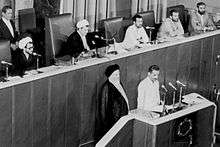
Iran's first Election Law was developed with Hashemi's partnership. He nominated as one of the Islamic Republican Party's candidates in the 1980 legislative election in Tehran. He gained 1,151,514 (54%) votes and ranked 15. Rafsanjani was the Speaker of Parliament of Iran for 9 years. He was elected as the speaker in 1980 in the first season of Parliament after the Iranian Revolution. He was also chairman in the second season and first year of the third parliament. After the death of Ruhollah Khomeini, founder of the Islamic Republic and election of then-President Ali Khamenei as new supreme leader, he joined the 1989 presidential race and became the President, leaving Parliament.
He had a determining role in the dismissal of Abulhassan Banisadr as commander-in-chief of Iranian military and then his impeachment in the parliament as Iran's first president in June 1981. In the summer of 1981, he protested to the veto of the parliament's plan by the Guardian Council and informed it to Ruhollah Khomeini. This led to the establishment of Expediency Discernment Council, which later he chaired the council. He had an active role in Iran–Contra affair, which was divulged by Mehdi Hashemi and failed. Mehdi Hashemi was executed but Rafsanjani was the loser at internal dimension.[25]

In October 1981 presidential election, when he voted to Ali Khamenei, he said it's vote of "Imam (Khomeini), clerics and the parliament". During differences between Prime Minister Mir-Hossein Mousavi and Khamenei, Hashemi cleverly managed to keep the position favor or against these two perspectives and take the middle position. According to Bahman Bakhtiari, at that time Mousavi was the leader of the left-wing, and Khamenei the right-wing. With the death of Khomeini (one of the supporters of leftists), leftists were weakened. In such circumstances, Hashemi leaped for a powerful presidency.[26]
Presidency
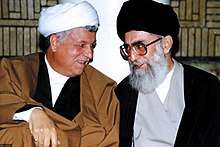
Rafsanjani adopted an "economy-first" policy, supporting a privatization policy against more state-owned economic tendencies in the Islamic Republic.[27] Another source describes his administration as "economically liberal, politically authoritarian, and philosophically traditional" which put him in confrontation with more radical deputies in the majority in the Majles of Iran.[28]
As president, Rafsanjani was credited with spurring Iran's reconstruction following the 1980–88 war with Iraq.[29] His reforms, despite attempting to curb the powers of the ultra-conservatives, failed to do so, and the Iranian Revolutionary Guards received increasing power from Khamenei during his presidency. He was also accused of corruption by both conservatives[30] and reformists,[31] and was known for tough crackdowns on dissent.[32]
Domestic policy
Rafsanjani advocated a free market economy. With the state's coffers full, Rafsanjani pursued an economic liberalization policy.[33] Rafsanjani's support for a deal with the United States over Iran's nuclear program and his free-market economic policies contrasted with Mahmoud Ahmadinejad and his allies, who advocate maintaining a hard line against Western intervention in the Middle East while pursuing a policy of economic redistribution to Iran's poor.[34] By espousing World Bank inspired structural adjustment policies, Rafsanjani desired a modern industrial-based economy integrated into the global economy.[35]
Rafsanjani urged universities to cooperate with industries. Turning to the quick pace of developments in today's world, he said that with "the world constantly changing, we should adjust ourselves to the conditions of our lifetime and make decisions according to present circumstances".[36] Among the projects he initiated are Islamic Azad University.[37][38]
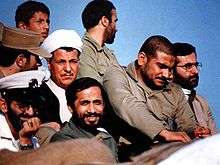
During his presidency, a period in which Rafsanjani is described by western media sources as having been the most powerful figure in Iran, people ordered executed by the judicial system of Iran included political dissidents, drug offenders, Communists, Kurds, Bahais, and even Islamic clerics.[39]
The Iranian Mojahedin were recognized as a terrorist organization by both the Iranian government as well as the United States CIA. Regarding the Mojahedin, Rafsanjani said (Ettela'at, 31 October 1981):
God's law prescribes four punishments for them (the Mojahedin). 1-Kill them. 2-Hang them, 3-Cut off their hands and feet 4-Banish them. If we had killed two hundred of them right after the Revolution, their numbers would not have mounted this way. I repeat that according to the Quran, we are determined to destroy all [Mojahedin] who display enmity against Islam.
Rafsanjani also worked with Khamenei to maintain the stability of government after the death of Khomeini.[40]
Foreign policy

Following years of deterioration in foreign relations under Khomeini during the Iran–Iraq War, Rafsanjani sought to rebuild ties with Arab states[41] as well as with countries in Central Asia and the Caucasus, including Azerbaijan, Turkmenistan and Kazakhstan.[42] However, relations with European countries and the United States remained poor, even though Rafsanjani had a track record of handling difficult situations and defusing crises.[43]
He condemned both the United States and Iraq during the Persian Gulf War in 1991. After the war he strove to renew close ties with the West, although he refused to lift Khomeini's fatwa against the British author Salman Rushdie.[44]
Rafsanjani said that Iran is ready to assist Iraq, "expecting nothing in return", he also said that "peace and stability" is a function of the "evacuation of the occupiers."[45]
Iran gave humanitarian help to the victims of the conflict. Iran sent truckloads of food and medicine to Iraq, and thousands of Kuwaiti refugees were given shelter in Iran.[46]
Rafsanjani voiced support to Prince Abdullah's peace initiative and to "everything the Palestinians agree to". He also stated that what he called "Iran's international interests" must take precedence over those of Iranian allies in Syria and Lebanon.[43]
Ayatollah Rafsanjani was a supporter of Iran's nuclear program. In 2007 Rafsanjani reiterated that the use of weapons of mass destruction was not part of the Islamic Republic culture. Rafsanjani said: "You [US and allies] are saying that you cannot trust Iran would not use its nuclear achievements in the military industries, but we are ready to give you full assurances in this respect."[47] According to The Economist, he is regarded by many Iranians "as the only person with the guile and clout to strike a deal with the West to end economic sanctions" imposed upon the country due to its nuclear program.[48]
After the Presidency
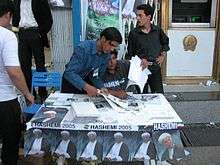
Post-presidency, Rafsanjani delivered a sermon at Tehran University in the summer of 1999 praising government use of force to suppress student demonstrations.[39]
In 2000, in the first election after the end of his presidency, Rafsanjani ran again for Parliament. In the Tehran contest, Rafsanjani came in 30th, or last, place. At first, he was not among the 30 representatives of Tehran elected, as announced by the Iranian Ministry of the Interior, but the Council of Guardians then ruled numerous ballots void, leading to accusations of ballot fraud in Rafsanjani's favor.[39]
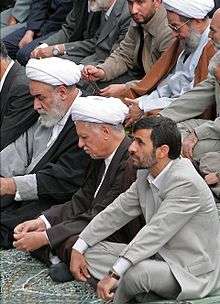
In December 2006, Rafsanjani was elected to the Assembly of Experts representing Tehran with more than 1.5 million votes, which was more than any other candidate. Ahmadinejad's opponents won the majority of local election seats. On 4 September 2007 he was elected Chairman of the Assembly of Experts, the body that selects Iran's supreme leader, in what was considered a blow to the supporters of Mahmoud Ahmadinejad. He won the chairmanship with 41 votes of the 76 cast. His ultraconservative opponent, Ayatollah Ahmad Jannati, received 31 votes.[49] Rafsanjani was re-elected to the position on 10 March 2009, running against Mohammad Yazdi. He received 51 votes compared to Yazdi's 26.[50][51] On 8 March 2011, he withdrew from the election and Ayatollah Mohammad Reza Mahdavi Kani was elected as his replacement.[52]
Following his presidency, Rafsanjani also became an advocate of greater freedom of expression and tolerance in Iranian society. In a speech on 17 July 2009, Rafsanjani criticized restriction of media and suppression of activists, and put emphasis on the role and vote of people in the Islamic Republic constitution.[53][54][55] The event has been considered by analysts as the most important and most turbulent Friday prayer in the history of contemporary Iran.[56] Nearly 1.5 to 2.5 million people attended the speech in Tehran.[57]
2009 election protests
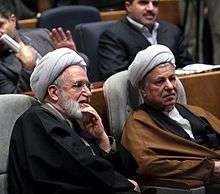
During the 2009 Presidential election, Rafsanjani's former rival and incumbent president, Mahmoud Ahmadinejad, won a disputed landslide victory over challenger Mir-Hossein Mousavi. His daughter was arrested on 21 June by plain clothes Basij during the subsequent protest[58] and later sentenced to six months in jail on charges of spreading propaganda against the Islamic Republic.[59]
Ayatollah Hashemi Rafsanjani was chairman of the Assembly of Experts, which is responsible for appointing or removing the Supreme Leader, who has been rumored to not be in the best of health.[60] After the disputed results of the election were certified by the Supreme Leader, Rafsanjani was reported to have called a meeting of the Assembly of Experts, but it is unknown what the outcome or disposition of this meeting actually was.[61] During this time Rafsanjani relocated from Tehran to Qom, where the country's religious leaders sit. However, for the most part, Rafsanjani was silent about the controversial 12 June election and its aftermath.[62]
On 17 July 2009, Rafsanjani publicly addressed the election crisis, mass arrests and the issue of freedom of expression during Friday prayers. The prayers witnessed an extremely large crowd that resembled the Friday prayers early after the revolution. Supporters of both reformist and conservative parties took part in the event. During prayers, Rafsanjani argued the following:[63]
All of us the establishment, the security forces, police, parliament and even protestors should move within the framework of law... We should open the doors to debates. We should not keep so many people in prison. We should free them to take care of their families. ... It is impossible to restore public confidence overnight, but we have to let everyone speak out. ... We should have logical and brotherly discussions and our people will make their judgments. ... We should let our media write within the framework of the law and we should not impose restrictions on them. ... We should let our media even criticize us. Our security forces, our police and other organs have to guarantee such a climate for criticism.[64]
His support for the Green Movement reinvigorated his image among the urban middle-class segments of Iranian society who made up the bulk of the movement and solidified Rafsanjani's role as a backer of factions within Iran that advocated the reform of the system to ensure its survival.
Assembly of Experts election
On 8 March 2011 Rafsanjani lost his post as chairman of the powerful Assembly of Experts, replaced by Ayatollah Mohammad-Reza Mahdavi Kani. Rafsanjani stated that he withdrew from the election for chairman to "avoid division." The loss was said to be the result of intensive lobbying "in recent weeks" by "hardliners and supporters" of President Mahmoud Ahmadinejad, and part of Rafsanjani's gradual loss of power over the years.[65]
2013 presidential elections
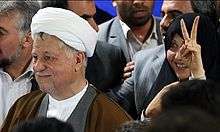
On 11 May 2013, Rafsanjani registered for the 14 June presidential election with just minutes to spare.[66] Former reformist president Mohammad Khatami endorsed him.[67] However, on 21 May 2013, Iran's electoral center, Guardian Council disqualified him from standing in the presidential election.[68] On 11 June 2013, Rafsanjani endorsed moderate Hassan Rouhani in the elections for Iran's presidency saying the candidate was "more suitable" than others for presidency.[69]
Later years
Reformers had enjoyed his support in recent years, helping to tilt the balance of power towards more moderate forces who managed to win the presidential poll in 2013 with the victory of Hassan Rouhani and parliamentary elections in 2016.
Rafsanjani could not act as a political horse trader—for example, he could not prevent reformist candidates from being disqualified—but his role in guiding reformist politicians was a crucial one and, up to a point, he was able to influence Khamenei by preventing him from making one-sided decisions. Hardliners now have a chance to completely surround the Supreme Leader and block moderate influences. Rafsanjani played politics the way it was played during the time of Ayatollah Khomeini—or at least, that is what he wanted you to believe—but with his death the so-called "Imam's Line," key figures from the beginning of the Revolution, who were close to Khomeini—is near its end.[70]
He also kept his traditional connections with the clergy in the holy city of Qom and with conservative forces within the political establishment, which made it difficult for hardliners to form a strong front against moderate forces.[71]
After winning reelection to his seat at Assembly of Experts as Tehran district's first person, Rafsanjani announced that it was the last time that he joined an election as a candidate and will be retired from politics at the end of the current term. He also said "Now I can die with peace of mind" after seeing election of a moderate parliament in the 2016 legislative election.[72]
Death
| Wikinews has related news: |
Rafsanjani died on 8 January 2017, at 19:30 (UTC+03:30) due to a heart attack in a pool. He was brought immediately to Tajrish's Shohada-ye Tajrish Hospital in north Tehran, as reported by Iranian state-run media.[73][74][75] He was 82 years old at the time of his death. The government announced three days of national mourning and a public holiday on his funeral day. Black banners were raised in Tehran and other cities and some posters showed the Supreme Leader and Rafsanjani together smiling. Five days of mourning also observed in the southern province of Kerman, where Ayatollah Rafsanjani's hometown of Rafsanjan is located.
Two months after his death, a street in Tehran's Sa'adat Abad was renamed in his honour. Many streets in other cities also named Hashemi Rafsanjani. The central building of Azad University also named as Hashemi Building and a statue of him was installed outside of the building. Kerman International Airport was also renamed to Ayatollah Hashemi Rafsanjani Airport.
Controversies
Accusations
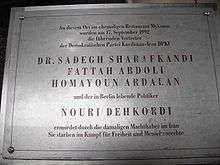
Rafsanjani was sought by the Argentinian government for ordering the 1994 AMIA bombing in Buenos Aires.[76] It was based on the allegation that senior Iranian officials planned the attack in an August 1993 meeting, including Khamenei, the Supreme Leader, Mohammad Hejazi, Khamenei's intelligence and security advisor, Rafsanjani, then president, Ali Fallahian, then intelligence minister, and Ali Akbar Velayati, then foreign minister.[77]
In 1997 during the Mykonos trial in Germany, it was declared that Rafsanjani, the then president of Iran, alongside Ayatollah Khamenei, Velayati and Fallahian had a role in the assassination of Iran's opposition activists in Europe.
Tension with Ahmadinejad
After his loss at the presidential elections in 2005, a growing tension between him and President Ahmadinejad arose. Rafsanjani has criticized Ahmadinejad's administration several times for conducting a purge of government officials,[78] slow move towards privatization[79] and recently hostile foreign policy in particular the atomic energy policy.[80] In return Ahmadinejad fought back that Rafsanjani failed to differentiate privatization with the corrupt takeover of government-owned companies and of foreign policies which led to sanctions against Iran in 1995 and 1996.[81][82] He also implicitly denounced Rafsanjani and his followers by calling those who criticize his nuclear program as "traitors".[83]
During a debate with Mir-Hossein Moussavi in 2009 presidential election, Ahmadinejad accused Hashemi of corruption. Hashemi released an open letter in which he complained about what he called the president's "insults, lies and false allegations" and asked the country's supreme leader, Ali Khamenei, to intervene.[84]
Tension with Khamenei
In his latter years, Rafsanjani had disagreements with Ali Khamenei who has the last say in everything in Iran. Khamenei even indirectly called Rafsanjani a traitor.[85] Khamenei acknowledged that he and Rafsanjani had differences after Rafsanjani's death,[86] and referred to Rafsanjani with the lower status title of Hujjat al-Islam.[87][88][89]
Views
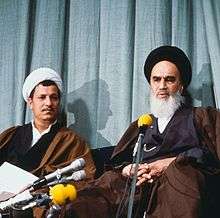
According to him, the problem of having political party undertook by common sense and people. In other word Islam has not definite opinion on parties. Islam placed the duty of having party on the shoulders of peoples themselves. Islam has not any disagreement with partition. He believes that all parties before Islamic revolution in Iran controlled by Shah Regime and there was no original party in that time. In fact with victory of Islamic revolution, the existence of part becomes necessary for revolution.[90]
Political parties
Before Iranian Revolution, Rafsanjani was active in the anti-Shah activities and reportedly associated with the Islamic Coalition's shura-ye ruhaniyat (lit. 'Council of the Clergy')[91] and the People's Mujahedin.[92]
Although Rafsanjani was a member of the pragmatic-conservative Combatant Clergy Association, he had a close bond to the Executives of Construction Party and Moderation and Development Party.[93] In 2009, Rafsanjani ceased activity in the Combatant Clergy Association, despite remaining a member.[94][95]
He was regarded as flip-flopping between conservative and reformist camps since the election of Mohammad Khatami, supporting reformers in that election, but going back to the conservative camp in the 2000 parliamentary elections as a result of the reformist party severely criticizing and refusing to accept him as their candidate. Reformists, including Akbar Ganji, accused him of involvement in murdering dissidents and writers during his presidency. In the end, the major differences between the Kargozaran and the reformists party weakened both and eventually resulted in their loss at the presidential elections in 2005. However, Rafsanjani regained close ties with the reformers since he lost the 2005 presidential elections to Mahmoud Ahmadinejad.[33]
Islamic Republican Party
Hashemi refers to the point that the Islamic Republican Party established in the early years of revolution in Iran. Ruhollah Khomeini, at first step, was disagree with establishment of Party because he known the establishment of party as something gradually. But After consultation of Hashemi with Khomeini, the opinion of Khomeini has changed. There were many negotiations and consultations on the instructions of Party. People like Yadollah Sahabi and Habibollah Peyman were to communicate but after a while there were no communication with them. Although Mortaza Motahhari had not any disagreement to establishing party but at the same time he hadn't any communication with party. In fact, the idea of establishment of republic party was necessary in order to give the Mullahs an organization and political collection. The party has established formally on 17 February 1979, namely two weeks after the victory of Islamic Revolution. The members of the party even determined their members in Kanoon Touhid in early days. The financial expenses of party originated from the voluntary aids of people. At first, religious scholars or clerics took part in the party. In early days there were no financial problem but after a while the problem appeared. Khomeini tried to give financial aid to the party with giving money. The members primarily chose from revolutionary individuals and believed persons.[96]
Electoral history
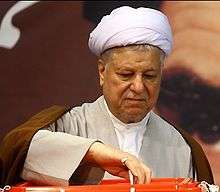
| Year | Election | Votes | % | Rank | Notes |
|---|---|---|---|---|---|
| 1980 | Parliament | 1,151,514 | ≈54 | 15th | Won |
| 1982 | Assembly of Experts | 2,675,008 | 84 | Won | |
| 1984 | Parliament | 1st | Won | ||
| 1988 | Parliament | 1st | Won | ||
| 1989 | President | 15,537,394 | 96.1 | 1st | Won |
| 1990 | Assembly of Experts | Won | |||
| 1993 | President | 1st | Won | ||
| 1998 | Assembly of Experts | Won | |||
| 2000 | Parliament | 30th | Won but withdrew | ||
| 2005 | President | 1st | Went to run-off | ||
| President run-off | 2nd | Lost | |||
| 2006 | Assembly of Experts | 1st | Won | ||
| 2013 | President | – | Disqualified | ||
| 2016 | Assembly of Experts | 1st | Won | ||
Personal life
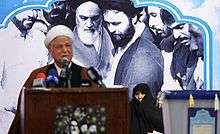
From his marriage to Effat Marashi in 1958, Rafsanjani had three sons: Mohsen, Mehdi, and Yasser, as well as two daughters, Fatemeh and Faezeh.[19] Only Faezeh Hashemi chose a political life, which led to her becoming a Majlis representative and then the publisher of the weekly newspaper Zan (meaning Woman in English), which was closed in February 1999.[97] In 2016, his daughter, Faezeh Hashemi, sparked a debate on religious persecution in Iran by visiting the female leader of the persecuted Bahai religious minority.[98] The two women had met in prison, when Faezeh was serving a six-month sentence for "spreading propaganda against the system." Another Rafsanjani's daughter, Fatemeh is President of Charity Foundation for Special Diseases and Mohsen was chairman of Tehran Metro Organization[99] and now is vice president of Azad University. His wife, Effat is the granddaughter of Mohammed Kazem Yazdi.
Family tree
| Mirza Ali | Mah-Bibi Safarian | ||||||||||||||||||||||||||||||||||||||||||||||||||||||||||||||||||||||||||||||||||
| Tayyebeh | Tahereh | Sedigheh | Akbar | Effat Marashi | Mahmoud | Ahmad | Ghasem | Mohammad | |||||||||||||||||||||||||||||||||||||||||||||||||||||||||||||||||||||||||||
| Fatemeh | Saeed Lahouti | Mohsen | Azam Hashempour | Faezeh | Hamid Lahouti | Mehdi | Fereshteh | Yasser | Maryam Salari | ||||||||||||||||||||||||||||||||||||||||||||||||||||||||||||||||||||||||||
| Sara Lahouti | Emad | Ehsan | Alireza | Mona Lahouti | Hassan Lahouti | Foad | Yasin | Leili | |||||||||||||||||||||||||||||||||||||||||||||||||||||||||||||||||||||||||||
Assets
The Rafsanjani family took their name from his great grandfather, whose last name was Hashem. When Akbar Hashemi was born, his father was a rich businessman with a valuable pistachio business.[102]
Hashemi and his partners also owned Islamic Azad University, worth an estimated US$20–25 billion.[103][104]
Assassination attempts
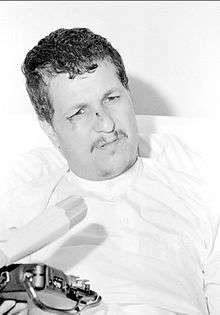
Only months after the revolution, Rafsanjani was shot once in the stomach by gunmen[105] from one of the groups vying for power amid the political turmoil. He was not seriously wounded—and neither was his wife, who jumped in front to shield him from the attack. "Great men of history do not die", Khomeini said in announcing that Rafsanjani had survived.
Books
- Memories
- The Combat Era is the title of his book on the events before the 1979 revolution. His devotion to Rouhollah Khomeini, his sympathy with the national movement including Mohammad Mosaddegh and Mahdi Bazargan is seen in this book. In this book, he even shows interest in western democracy.[106]
- Amir Kabir: the Hero of Fighting against Imperialism (1968)[107]
- Tafsir Rahnama[108]
- Explicit Letters
In addition, the full text of his Friday Prayer sermons and his congress keynote speeches are also published separately.[109] Based on his diary, viewpoints, speeches and interviews, several independent books have been published so far.
- Encyclopedia of Quran (Farhang-e-Quran)
The book in fact considered as a key to the subjects and concepts of Quran. The book has been written by Hashemi and several other scholars.[110]
Analysis
Although he was a close follower of Ayatollah Khomeini and considered as a central elite during Islamic revolution, at the same time he was fan of reconstruction of shattered country after war and according to this fact, he selected his cabinets from western-educated technocrats and social reformers. His cabinet largely was a reformist one. Rafsanjani acquired both the support of Imam Khomeini in one hand and Majlis in other hand. In fact, he tried to transfer the economy towards the free-market system. There was a gap among Rafsanjani and Khatami and reform agenda because of his partnership with those who were conservative. The first face of reformist movements began by Rafsanjani.[111]
See also
- Government of Akbar Hashemi Rafsanjani (1989–97)
References
- "letter to Hashemi Rafsanjani and resignation from presidency" (in Persian). Khamenei.ir. 16 August 1989. Retrieved 17 July 2018.
- Sciolino, Elaine (19 April 1992). "Rafsanjani Sketches Vision of a Moderate, Modern Iran". The New York Times. Archived from the original on 21 June 2009. Retrieved 9 June 2009.
- Poursafa, Mahdi (20 January 2014). گزارش فارس از تاریخچه نشانهای نظامی ایران، از «اقدس» تا «فتح»؛ مدالهایی که بر سینه سرداران ایرانی نشسته است [From "Aghdas" to "Fath": Medals resting on the chest of Iranian Serdars] (in Persian). Fars News. Retrieved 21 October 2014.
- "Ayatollah Ali Akbar Hashemi Rafsanjani, Ex-President of Iran, Dies at 82". The New York Times. 8 January 2017.
- In Rafsanjani’s election to key post, Iran moderates see victory Indian Express, 6 September 2007
- Iran's Rafsanjani Loses Key Post On Assembly Of Experts Radio Free Europe/Radio Liberty, 8 March 2011
- Wright, Robin. "Rafsanjani, Iran's Wiliest Revolutionary, Dies". The New Yorker.
- Ian Black. "Iran election: Rafsanjani defends decision to stand as his 'national duty'". The Guardian.
- "Iran's Rafsanjani Registers for presidential race". AP. Archived from the original on 11 June 2013. Retrieved 11 May 2013.
- "Iran's ex-President Rafsanjani dies at 82". 8 January 2017.
- "Former Iranian President Akbar Hashemi Rafsanjani dead". 8 January 2017.
- "Iran's ex-president Hashemi Rafsanjani dies at 82". 8 January 2017.
- "Iran reopens investigation into Rafsanjani death".
- "Iranian politics after the nuclear deal". The Economist. 28 May 2016. Retrieved 29 May 2016.
- RK Ramazani, Revolutionary Iran: Challenge and Response in the Middle East, Johns Hopkins University Press, 1987.
- Ayatollah Akbar Hashemi-Rafsanjani Archived 28 December 2006 at the Wayback Machine from Radio Free Europe
- "Iran Report: May 9, 2005". RadioFreeEurope/RadioLiberty.
- "Rafsanjani's possible return creates a buzz in Tehran". Financial Times.
- "Profile – Hoj. Ali Akbar Rafsanjani". APS Review Gas Market Trends. 19 April 1999. Retrieved 19 June 2013.
- برخی ناگفته های محمد هاشمی. Tabnak. Archived from the original on 16 August 2017. Retrieved 8 January 2017.
- "Profile: Akbar Hashemi Rafsanjani". BBC News.
- "زندگینامه اکبرهاشمی رفسنجانی". 9 January 2017. Archived from the original on 14 June 2012. Retrieved 10 January 2017.
- "Rafsanjani, Iran leader whose life mirrored nation's, dies". 9 January 2017.
- "Rafsanjani, dead at 82, was one of the titans of post-revolutionary Iran". 9 January 2017.
- "Influential former Iranian President Akbar Hashemi Rafsanjani dies age 82". 9 January 2017.
- "Rouhani Loses Key Ally as Former Iran Leader Rafsanjani Dies". 9 January 2017.
- Pasri, Trita, Treacherous Alliance: The Secret Dealings of Israel, Iran and the United States, Yale University Press, 2007, p.132
- Brumberg, Daniel, Reinventing Khomeini: The Struggle for Reform in Iran, University of Chicago Press, 2001, p.153
- John Pike. "Hojjatoleslam Akbar Hashemi Rafsanjani". Globalsecurity.org. Retrieved 28 January 2011.
- "Is Khameini's Ominous Sermon a Turning Point for Iran?". Time. 19 June 2009.
- "It is a quirk of history that Mr. Rafsanjani, the ultimate insider, finds himself aligned with a reform movement that once vilified him as deeply corrupt." Slackman, Michael (21 June 2009). "Former President at Center of Fight Within Political Elite". The New York Times.
- The Legacy Of Iran’s Powerful Cleric Akbar Hashemi Rafsanjani
- Rafsanjani's political life reviewed – in Persian.
- "Voice of ambition". The Guardian. London. 23 June 2006. Retrieved 23 April 2010.
- Book: Factional politics in post-Khomeini Iran By Mehdi Moslem
- Rafsanjani urges universities to cooperate with industries Archived 29 September 2007 at the Wayback Machine, IRNA
- Rafsanjani to Ahmadinejad: We Will Not Back Down, ROOZ Archived 30 October 2007 at the Wayback Machine
- يادگارهاي مديريت 16 ساله :: RajaNews Archived 13 March 2007 at the Wayback Machine
- Sciolino, Elaine (19 July 2009). "Iranian Critic Quotes Khomeini Principles". The New York Times.
- David Menashri (2001). post revolutionary politics in iran. Frank Cass. p. 62.
- Mafinezam, Alidad and Aria Mehrabi, Iran and its Place Among Nations, Greenwood, 2008, p.37
- Mohaddessin, Mohammad, Islamic Fundamentalism, Anmol, 2003, pp.70–72
- Al-Ahram Weekly|Region|Showdown in Tehran Archived 12 January 2007 at the Wayback Machine
- Akbar Hashemi Rafsanjani Biography – Biography.com
- Iran ready for comprehensive assistance to the Iraqi nation – Rafsanjani – Irna Archived 14 January 2007 at the Wayback Machine
- Iran's Persian Gulf Policy: From Khomeini to Khatami, by Christin Marschall
- John Pike. "Rafsanjani reassures West Iran not after A-bomb". globalsecurity.org.
- "A candidacy conundrum". The Economist.
- Slackman, Michael (5 September 2007). "Ex-President Back in Spotlight in Iran, as He Wins Leadership of Council". The New York Times.
- انتخاب مجدد هاشمی به ریاست خبرگان (in Persian). 10 March 2009.
- انتخاب مجدد هاشمی رفسنجانی به ریاست مجلس خبرگان (in Persian). BBC Persian. 10 March 2009.
- Rafsanjani ousted from Iranian post, Al Jazeera English, 8 March 2011
- بهروز کارونی (17 July 2009). اکبرین: هاشمی به صراحت وجود اختناق را تایید کرد - 2011تمام حقوق این وبسایت بر اساس قانون کپیرایت برای رادیو فردا محفوظ است. Radio Farda. Retrieved 28 January 2011.
- Daragahi, Borzou; Mostaghim, Ramin (18 July 2009). "Iranian protesters galvanized by sermon". Los Angeles Times.
- "Clashes as key Iranian cleric warns leaders". CNN. 18 July 2009.
- اعتراضیترین نمازجمعهی تاریخ معاصر ایران. Deutsche Welle. 17 July 2009. Retrieved 28 January 2011.
- پايگاه خبری تحليلی فرارو - جمعيت حاضر در نماز جمعه تهران چقدر بودند؟. Fararu. Archived from the original on 10 April 2010. Retrieved 28 January 2011.
- Amir Farshad Ebrahimi's video taped confession transcript Archived 29 May 2009 at the Wayback Machine
- "Hashemi Rafsanjani's daughter arrested". PressTV. 24 September 2012. Archived from the original on 25 September 2012.
- Iran Sources Dismiss Buzz Over Khamenei Health RFEFL, 15 October 2009
- World leaders urged by Iran's opposition party to reject Ahmadinejad's alleged victory Julian Borger and Ian Black, The Guardian, 14 June 2009
- "Rafsanjani's future at stake in Iran turmoil". Reuters. 26 June 2009.
- "Rafsanjani backs tolerance, dialogue" Los Angeles Times, 2009
- Daragahi, Borzou; Mostaghim, Ramin (17 July 2009). "In Iran, tensions build ahead of Rafsanjani's Friday sermon". The Los Angeles Times.
- Iran: Ex-Leader Rafsanjani Loses Role Archived 11 March 2011 at the Wayback Machine, by AP / Ali Akbar Dareini, 8 March 2011
- Akbar Hashemi Rafsanjani to stand in Iran presidential election| The Guardian
- Rafsanjani's last-minute entry transforms Iranian race – Yahoo! News
- Bahmani, Arash (22 May 2013). "The Arbiter of State Expediency is Disqualified". Rooz. Archived from the original on 27 October 2013. Retrieved 16 June 2013.
- "اعلام حمایت هاشمی رفسنجانی از روحانی". BBC Persian.
- "How Akbar Hashemi Rafsanjani's Death Will Empower the Ayatollah". 9 January 2017.
- "Akbar Hashemi Rafsanjani, Iranian politician, 1934–2017". 9 January 2017.
- "Iran's reformists stand to lose from Rafsanjani's death". 8 January 2017.
- Torbat, Akbar (2017), The Legacy Of Iran's Powerful Cleric Akbar Hashemi Rafsanjani
- اکبر هاشمی رفسنجانی درگذشت. BBC Persian Service.
- Erdbrink, Thomas (8 January 2017). "Death of Iran's Rafsanjani Removes Influential Voice Against Hard-Liners". The New York Times. Retrieved 8 January 2017.
- Ayatollah Ali Akbar Hashemi Rafsanjani, Ex-President of Iran, Dies at 82
- Barsky, Yehudit (May 2003). "Hizballah" (PDF). The American Jewish Committee. Archived from the original (Terrorism Briefing) on 29 October 2013. Retrieved 5 August 2013.
- "Rafsanjani slams Iran president". BBC News. 17 November 2005. Retrieved 23 April 2010.
- Harrison, Frances (23 January 2007). "Criticism of Ahmadinejad mounts". BBC News. Retrieved 23 April 2010.
- Rafsanjani, Ahmadinejad Engage in New War of Words (ROOZ: English) Archived 16 November 2007 at the Wayback Machine
- حمله به دولت در اولين كنفرانس خبري پس از 9 سال Raja News Archived 8 March 2007 at the Wayback Machine
- نمیپذیریم عده ای حرف خود را به نام سند چشم انداز مطرح کنند Raja News Archived 29 January 2007 at the Wayback Machine
- "Iran president attacks 'traitors'". BBC News. 12 November 2007. Retrieved 23 April 2010.
- Worth, Robert F. (11 June 2009). "In Iran Race, Ex-Leader Works to Oust President". The New York Times.
- http://www.al-monitor.com/pulse/originals/2016/03/khamenei-rafsanjani-treason-mohammadi-tweet-missiles.html
- http://www.presstv.ir/Detail/2017/01/08/505384/Iran-Leader-Ayatollah-Seyyed-Ali-Khamenei-Expediency-Council-Ayatollah-Akbar-Hashemi-Rafsanjani
- http://217.218.67.231/Detail/2017/01/10/505556/Iran-Rafsanjani
- Khamenei.ir [@khamenei_ir] (8 January 2017). "Sorrowfully I received news of sudden demise of my old friend esteemed Hojjat al-Islam wal-Moslemin Sheikh Akbar Hashemi Rafsanjani" (Tweet) – via Twitter.
- http://en.mehrnews.com/news/122580/Leader-pays-tribute-to-old-friend-Hashemi-Rafsanjani
- polotical party from Ayatollah Rafsanjani. methodology of oral history. 2000. pp. 271–272.
- Buchta, Wilfried (2000), Who rules Iran?: the structure of power in the Islamic Republic, Washington DC: The Washington Institute for Near East Policy, The Konrad Adenauer Stiftung, p. 15, ISBN 0-944029-39-6
- Leonard, Thomas M. Encyclopedia of the Developing World. Taylor & Francis. p. 1343. ISBN 0-415-97663-4.
- Abbas William Samii (2006), "The Iranian Nuclear Issue and Informal Networks", Naval War College Review, archived from the original on 14 May 2017, retrieved 26 June 2017
- روحانی، بهانه انشعاب جامعه روحانیت؟ [Rouhani: Excuse for Split in Combatant Clergy Association?]. Shargh (in Persian). Alef. 18 June 2016. Retrieved 25 June 2016.
- Mohammadighalehtaki, Ariabarzan (2012). Organisational Change in Political Parties in Iran after the Islamic Revolution of 1979. With Special Reference to the Islamic Republic Party (IRP) and the Islamic Iran Participation Front Party (Mosharekat) (PhD thesis). Durham University. p. 175–177.
- polotical party from Ayatollah Rafsanjani. methodology of oral history. 2000. pp. 275–286.
- Buchta, Wilfried (2000). Who Rules Iran? The Structure of Power in the Islamic Republic (PDF). Washington, DC: The Washington Inst. for Near East Policy [u.a.] ISBN 0-944029-39-6.
- "I am not regret of meeting Bahaee leader". Tasnim (in Persian). 2016. Retrieved 12 January 2017.
- "Mohsen Hashemi resignation" (in Persian). Parineh. Retrieved 12 January 2017.
- تصاویر منتشر نشده خانواده آیت الله هاشمی (in Persian). fararu.com. Retrieved 28 March 2015.
- شجره نامه هاشمی رفسنجانی (in Persian). shafaf.ir. Archived from the original on 11 April 2015. Retrieved 28 March 2015.
- "The Middle Road of Hashemi Rafsanjani". pbs.org. 28 April 2010. Retrieved 26 January 2017.
- "Archived copy" (PDF). Archived from the original (PDF) on 5 February 2016. Retrieved 26 January 2017.CS1 maint: archived copy as title (link)
- "Hashemi assets" (in Persian). Retrieved 12 January 2017.
- Hardline Ayatollah Shot in Tehran. Andrew Whitley, Financial Times, Saturday 26 May 1979; pg. 2; Edition 27,874.
- Moslem, Mehdi. Factional politics in post-Khomeini Iran. New York: Syracuse University Press, 2002. 371. ISBN 0-8156-2978-8.
- اکبر., هاشمی رفسنجانی، (1 January 1346). "امیرکبیر یا قهرمان مبارزه با استعمار". Retrieved 9 January 2017. Cite journal requires
|journal=(help) - یزدی،محمد علی. تفسیر راهنما از آغاز تا کنون. noormags.com.
- فارسی - ايران - نگاهی دیگر: خاطرات اکبر هاشمی رفسنجانی و حذف روایت کشتار ۶۷. BBC News.
- Sayyed Ali Sadat Fakhr (2006). Encyclopedia of Quran. AynehPajohesh. pp. 95–97.
- Anoushiravan Enteshami & Mahjoob Zweiri (2007). Iran and the rise of Neoconservatives, the politics of Tehran's silent Revolution. I. B. Tauris. pp. 4–5.
Further reading
- Torbat, Akbar (2017), The Legacy Of Iran’s Powerful Cleric Akbar Hashemi Rafsanjani
- Pesaran, Evaleila, Iran's Struggle for Economic Independence: Reform and Counter-Reform in the Post-Revolutionary Era, Editor: Taylor & Francis
- Amir Arjomand, Said, After Khomeini: Iran Under His Successors , Editor: Oxford University Press
- Moin, Baqer, (1999) Khomeini: Life of the Ayatollah, Editor: I.B.Tauris
- Nabavi, Negin,Iran: From Theocracy to the Green Movement, Editor: Palgrave Macmillan
External links
Official
Other
- All News About Akbar Hashemi Rafsanjani
- Iranian Economy in Six Snapshots
- Rafsanjani's response to some allegations (ISNA, in Persian)
- ISNA interview with Mohsen Hashemi Rafsanjani about the Rafsanjani family (in Persian)
- Friday Sermon at Tehran University: We Will Soon Join The Nuclear Club – For Peaceful Purposes (video clip from 3 December 2004)
- Video Archive of Akbar Hashemi Rafsanjani
- "The U.S. and Iran" by George Church
- Arms for Hostage Deals
| Political offices | ||
|---|---|---|
| Preceded by Hashem Sabbaghian |
Minister of Interior Acting 1979–1980 |
Succeeded by Mohammad-Reza Mahdavi Kani |
| Preceded by Ali Khamenei |
President of Iran 1989–1997 |
Succeeded by Mohammad Khatami |
| Chairman of the Expediency Discernment Council 1989–2017 |
Succeeded by Ali Movahedi-Kermani Acting | |
| Preceded by Ali Meshkini |
Chairman of the Assembly of Experts 2007–2011 |
Succeeded by Mohammad-Reza Mahdavi Kani |
| Military offices | ||
| Vacant | Deputy of Commander-in-Chief of the Iranian Armed Forces 1988–1989 |
Vacant |
| Academic offices | ||
| Preceded by None |
Chairman of Board of Trustees of Islamic Azad University 1982–2017 |
Succeeded by Ali Akbar Velayati |
| Assembly seats | ||
| Vacant Title last held by Javad Saeed |
Speaker of the Parliament 1980–1989 |
Succeeded by Mehdi Karroubi |
| Honorary titles | ||
| Preceded by Fakhreddin Hejazi |
Most voted MP for Tehran, Rey, Shemiranat and Eslamshahr 1984, 1988 |
Succeeded by Ali-Akbar Mousavi Hosseini |
.jpg)
